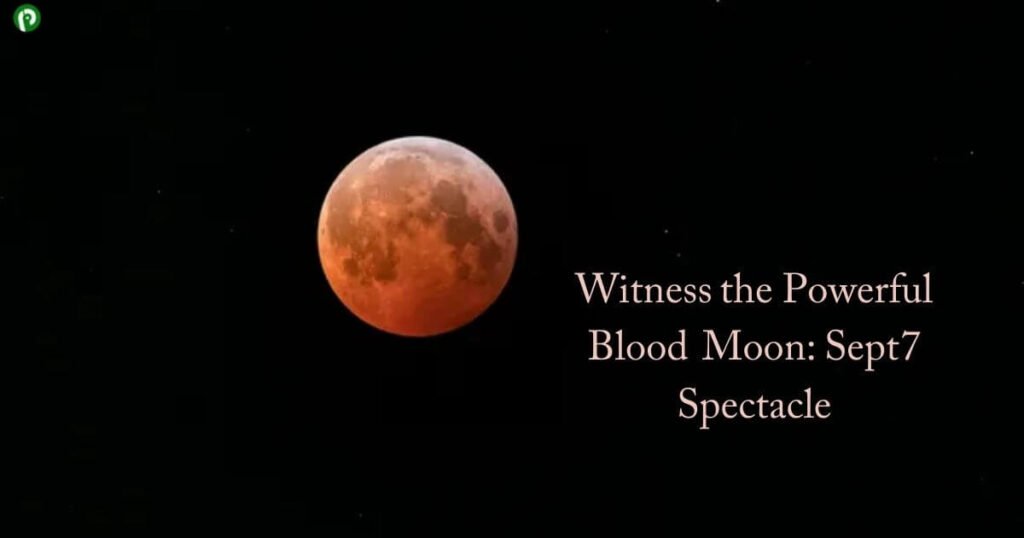Mark your calendars for a celestial event of raw power and beauty. On the evening of September 7th, the night sky will stage a breathtaking spectacle: a total lunar eclipse, transforming our familiar moon into a profound, coppery-red orb known as a Blood Moon. This occurs as the Earth aligns perfectly between the Sun and the Moon, casting our planet’s shadow and filtering sunlight through our own atmosphere.
The result is a mesmerizing, almost supernatural display that has captivated humanity for millennia. Step outside and witness this powerful, silent drama unfold—a rare chance to connect with the cosmos and experience a moment of pure, awe-inspiring wonder. Don’t miss it
Table of Contents
ToggleBlood Moon Light Up the Sky on 7 September
The September night sky transforms when Earth’s shadow creates a spectacular blood moon phenomenon, as totality brings forth a rusty red hue across the lunar surface. Stargazers witness this cosmic alignment where sunlight undergoes Rayleigh scattering, allowing longer red wavelengths to pass through Earth’s atmosphere while bluer wavelengths get deflected by atmospheric particles.
This total lunar eclipse occurs when our planet positions itself between the Sun and Moon, casting the deepest part of its umbra across the lunar disk. The crimson glow emerges as light becomes refracted and scattered through the thick atmosphere, saturating the moon in deep red tones that earn this celestial event its dramatic moniker.
What is a Total Lunar Eclipse / Blood Moon
A total lunar eclipse occurs when Earth perfectly aligns between the sun and moon, creating a shadow that transforms our natural satellite into a spectacular blood moon. This breathtaking phenomenon happens during the full moon phase when orbital mechanics position all three celestial bodies in perfect alignment, typically occurring three times per year. The moon’s tilted orbit ensures these events remain relatively rare, making each lunar spectacle particularly memorable for stargazers worldwide.
During totality, the lunar surface doesn’t disappear completely but takes on a dramatic reddish hue as Earth’s atmosphere filters sunlight, casting longer wavelengths onto the moon. This glorious sight can stretch for up to 82 minutes, allowing observers to witness the transformation with the naked eye without any risk to eyesight. The moon appears big, bright, and beautiful against the darkened night sky, creating an ideal opportunity for both casual viewing and astrophotography enthusiasts to capture this celestial dance.
Eclipse Timing and Duration
The lunar eclipse will unfold with precise astronomical timing, as Earth’s shadow passes across the Moon’s surface in a direct line of sight. Viewers in optimal position can expect totality to offer an unhindered spectacle, with the entire event spanning several hours from initial contact to final emergence.
From my years of eclipse observation, the beginning phases often prove most captivating – watching Earth’s curved shadow creep across the lunar surface creates an almost hypnotic progression. The end of totality arrives with surprising swiftness, as the Moon emerges from our planet’s umbral embrace, gradually returning to its familiar silver glow.
Visibility and Global Coverage
The viewers across vast areas of Asia will witness this eclipse unfold from beginning to end, while parts of Europe, Africa, and Australia experience varying degrees of lunar transformation. Having observed countless celestial events, I’ve learned that visibility depends on your ability to see the eclipse occur when the moon sits above the horizon during the critical moments.
The world experiences this phenomenon differently as it plays out across time zones – everyone won’t witness the same time events due to Earth’s rotation dictating celestial schedules. Globally, this Corn Moon spectacle remains visible to approximately 88% of humanity, making it one of the most widely observable lunar eclipses, though the longest totality phases favor those positioned in optimal geographic locations since the November 8, 2022 event.
Corn Moon Explanation

The full moon of September carries ancient agricultural significance, traditionally called the Corn Moon when crops reach maturity above fertile fields. This same celestial body that rises east of the horizon after sunset has dictated farming cycles for centuries, with its surface appearing particularly bright during harvest time. Native American groups witness this Moon as a signal that corn and other grains are ready for gathering, making it one of the most practically important lunar phases in the agricultural calendar.
Following the evening of Monday, this waning gibbous moon will continue to illuminate night areas where farmers traditionally worked by moonlight. The Corn Moon begins its cycle during a perfect time when darkness increases significantly, allowing communities to extend their harvest work without relying solely on artificial lighting. Saturn and other celestial bodies appear closer during these autumn months, creating a spectacular view for those who observe the night sky with binoculars or telescope equipment while the harvest season plays out across rural landscapes.
Viewing and Photography Tips
Optimal positioning demands finding elevated locations with unobstructed eastern views, as the moon will appear low on the horizon during totality. Equipment essentials include binoculars for enhanced detail, though naked-eye observation provides spectacular results for most viewers. Professional photographers should prepare cameras with telephoto lenses, stable tripods, and manual exposure settings to capture the reddish hue effectively.
Weather conditions will determine visibility success, so monitor local forecasts and identify backup viewing spots within reasonable driving distance. Urban light pollution doesn’t significantly impact lunar eclipse viewing, making this celestial event accessible from cities and suburbs. Digital photography works best with ISO settings between 400-800, while smartphone users can achieve remarkable results using night mode features.
What to Look Out for When the Blood Moon Rises on Sept. 7-8
During the September eclipse, observers should look for the moon‘s eastern rise around sunset, when the lunar spectacle begins to unfold with subtle changes in brightness. The best viewing experience requires finding a clear eastern horizon where buildings won’t block your view of the eclipsed moon as it approaches its peak phase.
Professional photographers and casual stargazers alike should prepare for the event by positioning themselves early, as the blood moon rises already partially eclipsed in many locations. Watch for the moon‘s color transformation from its normal brightness to the characteristic reddish glow, while Saturn appears close together in the sky, creating a spectacular celestial pairing worth capturing.
The Following Evening
The rising moon carries an otherworldly presence as darkness approaches and observers across multiple continents prepare for nature’s grand display. Eastern regions will witness the celestial transformation first, while western territories catch the lunar spectacle during their evening hours, creating a global symphony of astronomical wonder.
Photography enthusiasts armed with DSLR equipment and telescopes position themselves at carefully chosen locations, knowing this event demands both technical precision and artistic vision. The blood red coloration emerges gradually, transforming the familiar lunar surface into something almost alien, as Earth’s shadow creates this magnificent red eclipse that captivates millions worldwide.
Next Full Moon
After witnessing the celestial spectacle of September’s blood moon, sky watchers eagerly anticipate the next full moon phase. This lunar event will rise approximately one month later, offering another opportunity for astronomical observation. October‘s full moon traditionally marks a seasonal transition, when nights grow longer and winter sky patterns become more prominent across the northern hemisphere.
The upcoming full moon will appear with distinct characteristics compared to September’s eclipse. Without the Earth’s shadow creating that dramatic red glow, this lunar phase will shine with typical bright silver light visible throughout the night. Observers can expect optimal viewing conditions during moonrise, particularly when the moon reaches its highest point in the sky around midnight.
Upcoming Astronomical Events
The September sky promises extraordinary celestial displays, with the lunar eclipse creating a spectacular blood moon phenomenon that will captivate observers worldwide. This partial lunar eclipse occurs when Earth’s shadow gradually engulfs the moon, transforming its appearance into a mesmerizing reddish hue that has fascinated humanity for centuries.
Following this remarkable event, skywatchers can anticipate additional celestial opportunities, including optimal viewing conditions for planetary observations and the transition toward October’s full moon cycle. The eclipse represents just one highlight in a series of astronomical phenomena that will grace our night sky throughout the autumn months.
Livestream Information
Broadcasting platforms will capture the celestial event as Earth’s shadow transforms our natural satellite into a crimson spectacle. Professional astronomers and space agencies worldwide coordinate live coverage starting when the partial eclipse begins, ensuring viewers across different time zones witness this rare phenomenon.
Online streams provide real-time commentary from experts who explain the lunar eclipse mechanics while cameras track the moon’s gradual color transformation. Multiple feeds from various global locations offer diverse perspectives, allowing audiences to experience the blood moon even when weather conditions or geographical constraints prevent direct observation from their location.
Zainab Farooq is a dedicated reporter with Pakistan Coverage, committed to bringing readers timely and accurate information across diverse topics. With a passion for storytelling and fact-based reporting, she covers everything from local Pakistani developments to global trends, ensuring readers stay informed about the stories that shape our world.








